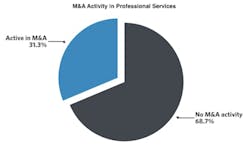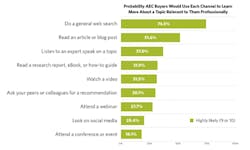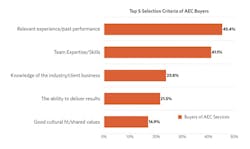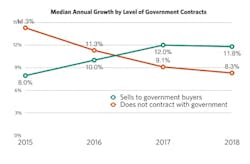7 AEC marketing trends to watch for in 2019
While AEC firms are catching up on integrated marketing and branding techniques, many continue to market their services the way they have for decades. These firms will begin adapting in 2019 — before it’s too late.
Marketing is changing rapidly. In 2018, we saw the impact of native LinkedIn video skyrocket, the Google Medic Update, and technology obsessions with blockchain, virtual reality and artificial intelligence get more intense.
So as we enter into the new year, I’d like to walk through seven marketing trends that will impact AEC firms in 2019 and beyond. Hopefully that will help you see what’s coming and prepare for upcoming challenges.
Trend 1: AEC firms are taking a strategic approach to M&A branding
We’re seeing it more and more. Professional services firms are starting to pursue mergers and acquisitions as a primary growth strategy. Our recent research shows nearly one-third of professional services firms were active in M&A in 2018.
While there are many benefits of growing via M&A, it can present new, complex marketing challenges, especially for AEC firms.
For example, in 2019 we worked with global, national and regional firms that had grown rapidly by strategically acquiring smaller firms for their specialized service offerings. The services they added were complimentary and the acquisitions brought valuable talent with them, but the new “house of brands” lacked cohesive positioning and messaging. We recognized a few of common needs shared by all of these firms:
- They needed to understand the brand strength of recently acquired firms to inform integration and communication plans (how much, how soon).
- They wanted to understand commonalities in external brand perceptions to help unify internal teams.
- The needed to develop a repeatable strategic approach to future acquisitions.
In each case we started with brand equity research, from which we were able to quantify the equity of each acquired brand, and uncover potential synergies and potential conflicts between them. Ultimately, these insights were used to develop integration plans and unified branding initiatives and strategies for future mergers.
Trend 2: As AEC buyers turn to Google more frequently throughout their journey, your website will continue to be a critical marketing tool
A generation raised on the web is fast becoming the beating heart of our industry. That means your website is only going to become more important to your firm’s success in the coming year. Today, 84% of AEC buyers check out a firm’s website during the buying process, and 83% have ruled out a potential service provider before even talking with them.
But that’s not all. As Millennials make more and more of the buying decisions, the way buyers find AEC service providers will change, too. Online search has become more important to the industry as buyers turn to online search before, during and after the selection process.
Once a business is aware of a challenge, the next step along their buyer’s journey is to research solutions. At this stage, 75% of AEC buyers will turn to Google or other search engines as a starting point. The service providers and teaming partners with the most visible expertise will have the advantage of first impression.
We’re seeing the fastest growing firms in the industry place higher emphasis on keyword research and SEO implementation. It would be wise for AEC marketers to follow suit and prioritize SEO in their 2019 marketing plan.
If you can’t be found in search, if your website is not mobile, and if your website cannot convey how your firm helps its clients, you’ll be at a significant disadvantage.
Trend 3: A continued focus on recruiting
For the past three years, a tough hiring market has persisted — architecture, engineering, construction and environmental talent remain in high demand, and there are simply not enough qualified people to fill every opening.
If the Trump administration’s commitment to the nation’s infrastructure comes to fruition, the need for talent will be even more urgent.
Forward-thinking business leaders understand that marketing not only needs to attract clients, it needs to attract talent, too. Look for firms to invest more in recruiting materials, career microsites and employer branding.
Trend 4: More emphasis on “productized” offerings
As AEC technology becomes more pervasive, and “big data” tools transfer from other markets and verticals - firms are recognizing the value of monetizing non-service revenue from technology platforms. Some of the advanced AI and machine learning tools we’ve seen used to address unstructured data search or data visualization challenges in healthcare, technology and government contracting are beginning to penetrate the AEC industry. Leading firms that are investing and exploring ways to incorporate these tools with their existing expertise and services. The ones that are able to demonstrate results, and clearly market these integrated tools will have a significant first-mover advantage.
Trend 5: A transition from relationships to expertise
Relationships have always been a critical driver of AEC firm success. But today’s buyers are becoming more discriminating. More than ever, they are seeking out experts with deep, specialized expertise — partners who can navigate complex projects and overcome unexpected challenges with relative ease.
In our recent study, Inside the Buyer’s Brain we saw that relevant experience and team expertise were the top two selection criteria of AEC buyers.
Many long-standing relationship-based partnerships will be tested as buyers become less tolerant of delays, cost overruns and permitting hassles. As a result, many firms will be positioning and marketing themselves as leading experts in specific disciplines. Firms bound together through teaming arrangements require even more cohesive messaging to make the overall team’s expertise clear.
Trend 6: More engaging content
One broad trend we’re seeing in professional services is the focus on engagement. Our recent research shows nearly 22% of professional services firms are using webinars in their marketing mix. By doing this, AEC marketers are able to reach an active, highly engaged segment of their audience.
Forward-looking firms are incorporating other engaging content on their websites, and are still able to optimize for online search. In this way, they’ll maximize their online visibility and nurture prospects for when the time is right.
Trend 7. Government contracting presents a growth opportunity...for now
Over the course of four years, we’ve observed declining rates of growth for firms that do not sell to government buyers.
It’s hard to ignore the current administration when looking at this graph. Before the election, we observed firms selling exclusively to private companies growing faster than those that sell to government buyers. Today, government contractors are growing more rapidly.
If the White House did in fact influence this trend, the future is largely dependent on 2020. Current conditions point to deadlock and should there be another change in administration, we could see trends reverse.
For AEC firms specializing in the residential and commercial markets, 2019 could continue to cool down. For engineering, environmental and construction firms with a focus in infrastructure and energy, 2019 should continue the upward trend we’ve been seeing. Whatever the new year holds, we should all be preparing for change and resiliency.





